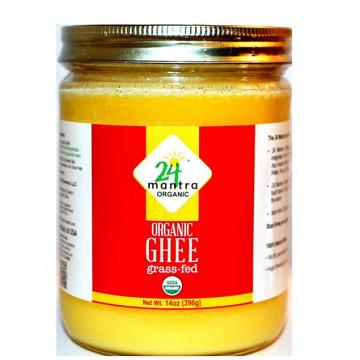Description
Our Grassfed Organic Cultured Ghee is made from the milk of pastured cows, fed on fresh green grass in spring thru fall. No GMOs, no added salt, no preservatives, no Trans Fats, no colors or dyes, no MSG, no flavor enhancers. The only ingredients are milk and cultures, with absolutely nothing else added to it. It is batch-tested Gluten-Free. It is also batch-tested to contain no more than 0.25% lactose and 2.5 ppm casein/whey.
World’s First Grass-fed and Certified Organic Cultured Ghee
This is world’s first Grass-fed and Certified Organic Cultured Ghee! Ghee is one of the most sacred and healing foods described by the ancient Ayurvedic texts. It is made by a simple process of gently simmering cultured butter to remove potential allergens such as casein and lactose. What remains is the pure delicious butter oil, described as conferring good health and longevity.
One of the traditional processes of making ghee involves culturing the cream before churning it into butter and then clarifying it into ghee. Pure Indian Foods Grass-fed Organic Cultured Ghee is made by following this age-old and time-honored practice. The result is a delightfully aromatic ghee with a slight tangy flavor characteristic of naturally cultured foods. And as always, Pure Indian Foods ghee is made from milk obtained only during the spring thru fall when the cows are on the pasture eating fresh, green grass.
Pure Indian Foods ghee never contains any artificial ingredients or harmful trans-fats. It has a naturally high smoke point of 485 F, so it won’t burn like butter. Use in place of oil or butter for cooking. It’s ideal for sautes, stir-fries and sauces and it’s delicious on rice, toast, pancakes, scones or biscuits.
Difference Between Ghee and Cultured Ghee
Milk contains lactose, a natural sugar which gives it that delicate sweet taste. In order for the body to breakdown lactose into its basic components of simple sugars called glucose and galactose, an enzyme called lactase must be present. Many people lack this valuable enzyme in their digestive system causing a common digestive problem known as lactose intolerance. In order to metabolize lactose, lactase must always be present. During the culturing process of milk or cream, lactose is converted into lactic acid. This makes for a much more digestible product for many people. Remember, generally ghee does not cause a problem with lactose intolerance. This is because during the ghee making process, the lactose is removed even if the butter used to make the ghee was not made from cultured cream.
Why Cultured Ghee?
- Cultured Ghee has a more buttery taste as a result of fermentation of the cream. Many people prefer the taste and aroma of cultured foods.
- Cultured Ghee is batch-tested Gluten-Free. It is also batch-tested to contain no more than 0.25% lactose and 2.5 ppm casein/whey. This testing has not been done for our Ghee.
- Our traditional Cultured Ghee recipe has been used for thousands of years. The ancient tradition of Ayurveda considers Cultured Ghee important for strengthening Agni, our powerful digestive fire.
Cultured Ghee is known as Desi Ghee in India, where the word desi means prepared with indigenous method. Please note that this product is not a source of live and active cultures.
For more information, visit here











Reviews
There are no reviews yet.